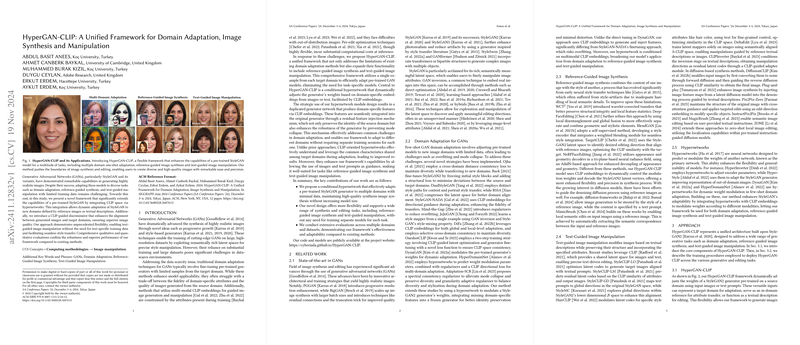An Analysis of HyperGAN-CLIP: A Versatile Framework for Image Domain Adaptation and Manipulation
The paper "HyperGAN-CLIP: A Unified Framework for Domain Adaptation, Image Synthesis and Manipulation" presents a novel approach for extending the capabilities of pre-trained Generative Adversarial Networks (GANs), particularly focusing on StyleGAN, by integrating Contrastive Language–Image Pretraining (CLIP) through hypernetworks. This research introduces an innovative methodology that enables task flexibility in image generation and editing, addressing persistent challenges such as domain adaptation, reference-guided synthesis, and text-driven image manipulation, especially in environments with limited data availability.
Technical Contributions
The primary technical innovation of this paper lies in the employment of conditional hypernetworks that facilitate dynamic adaptation of the StyleGAN generator to diverse tasks by leveraging CLIP embeddings. This integration allows the generation of domain-specific features based on CLIP's multi-modal embeddings, crucially without enlarging the model size. The hypernetwork architecture dynamically modifies the generator’s weights, guided by domain-specific CLIP embeddings derived either from textual descriptions or reference images, thereby ensuring adaptive manipulation capabilities.
A critical component of this framework is the residual feature injection mechanism that guarantees the preservation of the semantic identity from the source domain while accommodating new domain characteristics. This pragmatic feature injection is pivotal in minimizing overfitting and maintaining image quality. Moreover, the incorporation of a CLIP-based conditional discriminator enhances the alignment between generated and target domain images, further improving the fidelity of outputs.
Quantitative and Qualitative Evaluations
Empirical evaluations in the paper substantiate the effectiveness of HyperGAN-CLIP across multiple challenging benchmarks. The framework exhibited superior performance in domain adaptation tasks, as illustrated by lower Fréchet Inception Distance (FID) scores compared to existing techniques like StyleGAN-NADA, DynaGAN, and HyperDomainNet. Notably, the framework demonstrated high model flexibility by dealing with a mixture of domain adaptation scenarios using a unified model structure, an aspect where many traditional methods require separate models for each domain.
In the domain of reference-guided image synthesis, HyperGAN-CLIP achieved high semantic alignment as indicated by enhanced CLIP similarity metrics, while simultaneously maintaining robust identity preservation of source images. This balance is critical for applications necessitating faithful style transfer without identity distortion.
Similarly, in the text-guided image manipulation arena, despite not utilizing textual data during training, HyperGAN-CLIP showcased competitive performance against state-of-the-art models like StyleCLIP and DiffusionCLIP, effectively executing multi-attribute edits while maintaining input identity. This versatility underscores the potential of HyperGAN-CLIP in tasks that involve both single and multi-attribute transformations.
Implications and Future Directions
The proposed HyperGAN-CLIP framework marks a significant step forward in the utilization of GANs for diverse image generation and editing tasks across variable datasets. The strategic architecture leveraging hypernetworks and CLIP effectively addresses data scarcity challenges and offers a scalable solution for multiple domain adaptation. Its ability to synthesize high-quality images guided by minimal examples paves the way for applications in fields such as personalized content creation, style transfer in digital art, and flexible domain adaptation in computational photography.
Potential future developments could explore further integration with real-time editing systems, improving computational efficiency, and expanding the framework to other GAN variants and diffusion models. Additionally, incorporating a more intricate blend of multimodal inputs could amplify its applicability in zero-shot cross-domain synthesis and target-specific fine-tuning without task-specific retraining phases.
By addressing both theoretical and practical challenges in AI-driven image manipulation, this research contributes a robust and adaptable toolset, opening pathways to a more generalized approach for graphics and vision problems reliant on synthesized image quality and adaptability.
